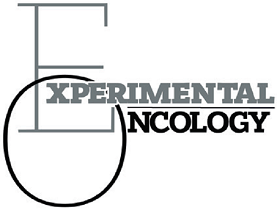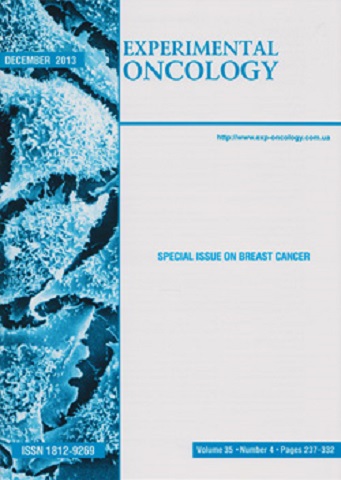ХІМІОРЕЗИСТЕНТНІСТЬ, ПОВ’ЯЗАНА З АДАПТАЦІЄЮ ДО ГІПОКСІЇ КЛІТИН МЕЗОТЕЛІОМИ В ПУХЛИННИХ СФЕРОЇДАХ
DOI:
https://doi.org/10.32471/exp-oncology.2312-8852.vol-44-no-2.18045Ключові слова:
хіміорезистентність, гіпоксія, пухлинні сфероїди, мезотеліома, стовбурність.Анотація
Стан питання: Гіпоксія є ключовим фактором, який впливає на індукцію та підтримку пулу пухлинних стовбурових клітин (ПСК), що в результаті забезпечує резистентність до терапії. Тривимірні (3D) сфероїдні моделі демонструють неоднорідність гіпоксичних ділянок, що відтворюють ситуацію in vivo в пухлинах. Використовуючи отримані 3D-сфероїд-моделі, нами проведено дослідження впливу гіпоксії на чутливість сфероїдів злоякісної мезотеліоми плеври до хіміотерапевтичних препаратів. Матеріали та методи: Пухлинні сфероїди, одержані з клітин Meso-1 (типова клітинна лінія ЗМП людини), які мають високу здатність до утворення сфероїдів. Для індукування стану гіпоксії було використано гіпоксичну камеру з регулюванням рівнів O2 і CO2. Життєздатність клітин оцінювали тестуванням з WST-8. Експресію досліджуваних маркерів на рівні мРНК і білка проводили із застосуванням полімеразної ланцюгової реакції в реальному часі та Western-блот-аналізу. Результати: Встановлено достовірно вищі показники маркерів ПСК (CD26, CD44 і ABCG2) на рівні мРНК та маркерів адаптації до гіпоксії (ABCG2, ALDH1A1 і HIFs) у клітинах сфероїдів порівняно з аналогічними показниками у моношаровій моделі (2D). Як наслідок, клітини сфероїдів є менш чутливими до дії перметрекседу і топотекану порівняно з клітинами в моношарі, що вказує на вищий потенціал для адаптації до гіпоксії. Продемонстровано підвищення резистентності до обох хіміотерапевтичних агентів у клітинах сфероїдів в умовах гіпоксії порівняно з клітинами, які культивувалися за умов нормоксії. Висновки: Отримані результати свідчать, що адаптація до гіпоксії клітин ЗМП в сфероїдах може посилити їх хіміорезистентність.
Посилання
Yang H, Testa JR, Carbone M. Mesothelioma epidemiology, carcinogenesis, and pathogenesis. Curr Treat Options Oncol 2008; 9: 147–57. https://doi.org/10. 1007/ s11864-008-0067-z
Bibby AC, Tsim S, Kanellakis N, et al. Malignant pleural mesothelioma: an update on investigation, diagnosis and treatment. Eur Respir Rev 2016; 25: 472–86. https://doi.org/10.1183/16000617.0063-2016
Zhao J. Cancer stem cells and chemoresistance: the smartest survives the raid. Pharmacol Ther 2016; 160: 145–58. https://doi.org/10.1183/16000617.0063-2016
Visvader JE, Lindeman GJ. Cancer stem cells in solid tumours: accumulating evidence and unresolved questions. Nat Rev Cancer 2008; 8: 755–68. https://doi.org/10.1038/nrc2499
Wilson WR, Hay MP. Targeting hypoxia in cancer therapy. Nat Rev Cancer 2011; 11: 393–410. https://doi.org/10.1038/nrc3064
Ishiguro T, Ohata H, Sato A, et al. Tumor-derived spheroids: relevance to cancer stem cells and clinical applications. Cancer Sci 2017; 108: 283–9. https://doi.org/10.1111/cas.13155
Lovitt CJ, Shelper TB, Avery VM. Advanced cell culture techniques for cancer drug discovery. Biology (Basel) 2014; 3: 345–67. https://doi.org/10.3390/biology3020345
Kandasamy S, Adhikary G, Rorke EA, et al. The YAP1 Signaling inhibitors, Verteporfin and CA3, suppress the mesothelioma cancer stem cell phenotype. Mol Cancer Res 2020; 18: 343–51. https://doi.org/10.1158/1541-7786. MCR-19-0914
Kaneko S, Sato C, Shiozawa N, et al. Suppressive effect of delta-tocotrienol on hypoxia adaptation of prostate cancer stem-like cells. Anticancer Res 2018; 38: 1391–9. https://doi.org/10.21873/anticanres.12362
Chaicharoenaudomrung N, Kunhorm P, Noisa P. Three-dimensional cell culture systems as an in vitro platform for cancer and stem cell modeling. World J Stem Cells 2019; 11: 1065–83. https://doi.org/10.4252/wjsc.v11.i12.1065
Cortes-Dericks L, Schmid RA. CD44 and its ligand hyaluronan as potential biomarkers in malignant pleural mesothelioma: evidence and perspectives. Respir Res 2017; 18: 58. https://doi.org/10.1186/s12931-017-0546-5
Amatya VJ, Takeshima Y, Kushitani K, et al. Overexpression of CD26/DPPIV in mesothelioma tissue and mesothelioma cell lines. Oncol Rep 2011; 26: 1369–75. https://doi.org/10.1186/s12931-017-0546-5.
Cortes-Dericks L, Carboni GL, Schmid RA, et al. Putative cancer stem cells in malignant pleural mesothelioma show resistance to cisplatin and pemetrexed. Int J Oncol 2010; 37: 437–44. https://doi.org/10.1186/s12931-017-0546-5
Mao Q, Unadkat JD. Role of the breast cancer resistance protein (BCRP/ABCG2) in drug transport — an update. AAPS J 2015; 17: 65-82.
Adjei AA. Pharmacology and mechanism of action of pemetrexed. Clin Lung Cancer 2004; 5: S51-5. https://doi.org/10.1208/s12248-014-9668-6
Kaneko S, Yamazaki T, Kohno K, et al. Combination effect of bowman-birk inhibitor and alpha-tocopheryl succinate on prostate cancer stem-like cells. J Nutr Sci Vitaminol (Tokyo) 2019; 65: 272–7. https://doi.org/10.3177/jnsv.65.272
Shaheen S, Ahmed M, Lorenzi F, et al. Spheroid-formation (colonosphere) assay for in vitro assessment and expansion of stem cells in colon cancer. Stem Cell Rev Rep 2016; 12: 492–9. https://doi.org/10.1007/s12015-016-9664-6
Kanellakis NI, Asciak R, Hamid MA, et al. Patient-derived malignant pleural mesothelioma cell cultures: a tool to advance biomarker-driven treatments. Thorax 2020; 75: 1004–8. https://doi.org/10.1136/thoraxjnl-2020-215027
Simon MC, Keith B. The role of oxygen availability in embryonic development and stem cell function. Nat Rev Mol Cell Biol 2008; 9: 285–96. https://doi.org/10.1038/nrm2354.
Das B, Tsuchida R, Malkin D, et al. Hypoxia enhances tumor stemness by increasing the invasive and tumorigenic side population fraction. Stem Cells 2008; 26: 1818–30. https://doi.org/10.1634/stemcells.2007-0724
Jögi A, Øra I, Nilsson H, et al. Hypoxia alters gene expression in human neuroblastoma cells toward an immature and neural crest-like phenotype. Proc Natl Acad Sci USA 2002; 99: 7021–6. https://doi.org/10.1073/pnas.102660199.
Tong WW, Tong GH, Liu Y. Cancer stem cells and hypoxia-inducible factors (Review). Int J Oncol 2018; 53: 469–76. https://doi.org/10.3892/ijo.2018.4417
Kilic-Fren M, Boylu T, Tabor V. Targeting PI3K/Akt represses hypoxia inducible factor-1α activation and sensitizes Rhabdomyosarcoma and Ewing’s sarcoma cells for apoptosis. Cancer Cell Int 2013; 13: 36. https://doi.org/10.1186/1475-2867-13-36
Pouysségur J, Dyan F, Mazure NM. Hypoxia signalling in cancer and approaches to enforce tumour regression. Nature 2006; 441: 437–43. https://doi.org/10.1038/nature04871
##submission.downloads##
Опубліковано
Як цитувати
Номер
Розділ
Ліцензія
Авторське право (c) 2023 Експериментальна онкологія

Ця робота ліцензується відповідно до Creative Commons Attribution-NonCommercial 4.0 International License.



